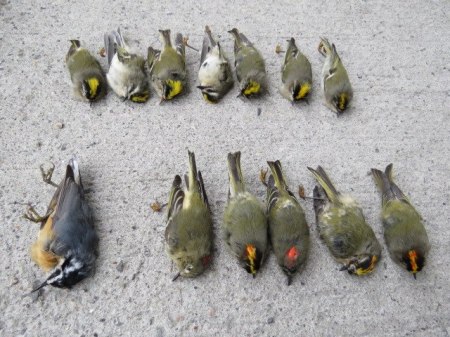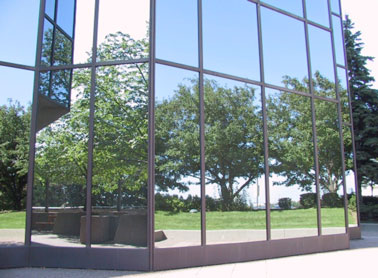Let Us Count The Ways....
"It feels like the right thing for me to be doing."
"You can go through life with a job where you don't feel like you're making any great contribution to the world, but I find this is the first thing I've done where I really feel it's contributing to a better world. It's something that's concretely, demonstrably useful."
"I believe that if you feel strongly that somebody ought to do something about a problem, then you should consider whether you might be the person to do something about it. And this is something I really care about."
"It's an issue that doesn't get enough attention; that not enough people are aware of. I just find it horrifying that this many birds die colliding with buildings."
Anouk Hoedeman, founder, co-ordinator, Ottawa branch, FLAP [Fatal Light Awareness Program]
 |
| Anouk Hoedeman holds a Golden-crowned Kinglet that died when it flew into the National Gallery of Canada -- Bruce Deachman/Ottawa Citizen |
There was a time when those concerned by the carnage of birds, not recognizing glass for what it amounts to; an impermeable threat to flight; tried to persuade those in charge of high rise office towers to shut off lights at night. That included government buildings. The theory being that birds would not fly into windows quite as frequently if they were not reflective as window glass and glass-fronted buildings tend to be, appearing to birds not to represent a solid shield not permissive of passage.
 |
FLAP, a Toronto-based organization whose purpose is to promote awareness and attempt to change not only building architecture, but the manner in which current buildings can be changed to shield avian flight from disaster in their efforts to safeguard migratory birds, use the tools of education, research, rescue and rehabilitation. Anouk Hoedman, who daily spends her morning hours in the city's downtown pursuing a quest for injured or dead birds, hopes her efforts count.
If she finds -- in the downtown corridors where glass-and-steel office towers pose such a hazard for birds navigating their way through urban centres on their way to warmer climes pre-winter arrival -- any birds that are injured she takes them to the Wild Bird Care Centre for care to hopefully resuscitate them and return them to their lives in the wild. Those she finds beyond care are carefully placed in paper packets to be frozen in the hope that ornithologists may wish to study them for migration patterns.
A year ago, Environment Canada estimated that buildings account for 22.5-million avian deaths annually in Canada. Power lines claim another 25.6-million birds. And then of course there is the growing prevalence of giant energy windmills on environmental wind farms that also take their toll. All of which shrink in magnitude of death traps in comparison to nature's having imbued cats with their instinct to kill.
The cat population in Canada alone is said to account for 196-million bird kills on an annual basis. Pet cats that are kept indoors don't prowl backyards and parks and gardens for the opportunity to kill birds. Or, for that matter, to kill squirrels, chipmunks, voles, mice, or wild rabbits. Tell that to their owners. But it is not the cats or the electrical lines or the windmill blades that are of concern to Anouk Hoedeman.
She hopes to do what she can to persuade building owners to use modern technology to ensure their glass and mirror-curtain-walled buildings become less lethal to birds in flight who cannot imagine that what they perceive as open air and sky and trees mirrored in glass really represents a wall that will stun them at least, or impact them with serious enough head wounds to kill them, sometimes outright, sometimes agonizingly slowly.
Over the course of two migratory seasons this year, Anouk Hoedeman and other FLAP Ottawa volunteers managed to rescue or retrieve roughly 450 birds representing over 60 species. FLAP estimates that 100-million to one billion birds die in North America yearly through these deadly impacts. But the handful of bird-loving volunteers do what they can, and find within their occupation to save the lives of these beautiful creatures, their own life-satisfaction.

These
13 migrating birds flew into a glass building in Kanata this morning.
No one likes looking at dead birds. Let’s support F.L.A.P. and see if we
can prevent this. Photo by Cynthia Paquin
Windows of these tall, mirrored buildings can be retrofitted with screens using material such as CollidEscape, which is an energy-efficient, Leadership in Energy and Environmental Design (LEED)-tested film that birds can see, to identify the window for what it is, a hard surface that will stop and destroy them. The beauty of that material placed over window glass is that the human eye can see right through it.
Cities like Toronto, Chicago, New York and San Francisco have seen their municipal councils agree to implement design guidelines for new buildings recognized as bird-friendly. A recognition that we are part of the environment that we manipulate with not much thought for the impact it has on the other living species we share our landscapes with.
And when we are reminded to give it some thought, every little bit counts.
Labels: Animal Welfare, Canada


0 Comments:
Post a Comment
<< Home